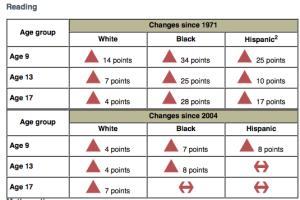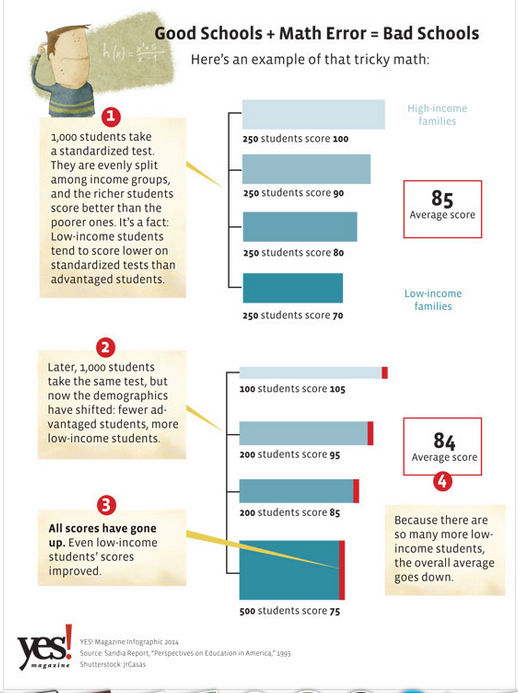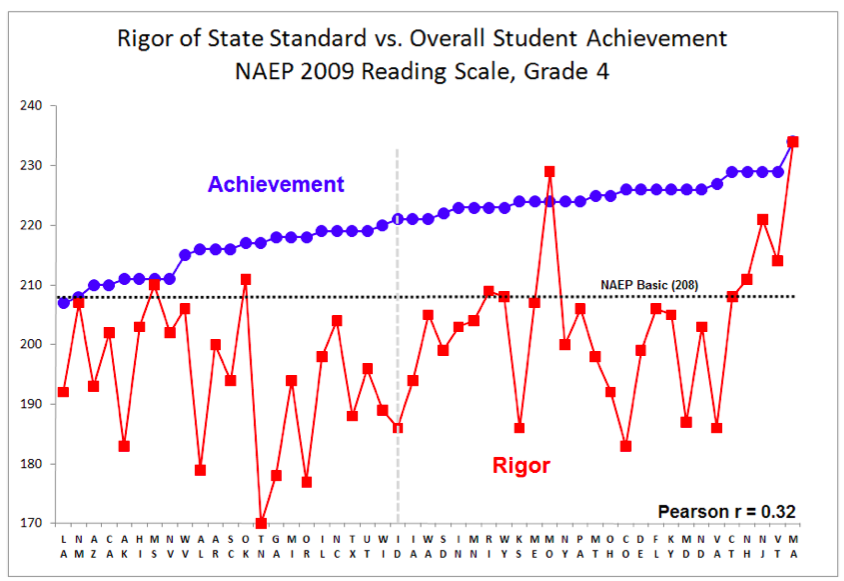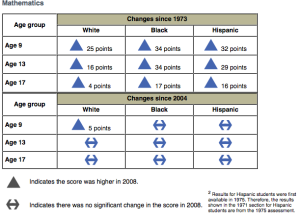Public education in America is at risk as long as mass deception can continue unchecked.
When it comes to education policies and the organizations and individuals pushing their agendas into law, the public is ill-equipped to distinguish truth from deception because of a long history of misinterpretation of statistics, massive misinformation, and outright political deception.
Truth: Schools must continuously be improving themselves.
That truth is based on the premise that the public education system faces ever-changing obstacles to offering equal educational opportunities — changing student populations, changing demographics of the students, turnover of school personnel, and a multitude of variables are demanding schools be responsive to societal pressures of all kinds. 
Truth: The public schools have made progress despite economic and political upheaval. Notable improvements were made in the 70’s through 90’s and is continuing but at a slowed pace.
Truth: Current education reform policies are based on deception.
Education reform became a problem when politicians took the reins and their driving premise required deception. As Douglass Cater, an adviser to President Johnson, explained,
“I think one of the major problems of politics is that [it] takes a fairly recognized crisis before the government is able to come to grips with …a problem in a policy area…”
Plus, there was fear that the general public would not stay involved in public school improvement unless there was an urgent need – a crisis. But this line of reasoning is no excuse for the mass deception that followed.
Policymakers of the 80’s moved forward with half-truths to put in motion an ideologically driven education reform agenda — standards, testing, and accountability based on achievement tests — the outcome-based theory that we can judge schools based on test scores.
And because the theory was intentionally marketed and the lies repeated so often, the deception became the public’s truth. Repeatedly, we acted on that “truth.”
So briefly, here’s how we Americans allowed ourselves to be deceived. Keep in mind, the public education system tends to be a reflection of society. A brief history of “the times” is necessary.
- “The 1960s were years of protest and reform.”… people worked together for social improvement particularly for minorities, the poor, and women.
- “The period of change came during the 1970s…an economic recession. Interest rates and inflation were high. There was a shortage of imported oil.”
- “As the 1970s moved toward the 1980s, Americans became tired of social struggle…many wanted to spend more time on their own personal interests…It affected popular culture, education, and politics.”
- “The 1980s were called the Reagan years, because he was president for eight of them….the recession ended….[creating] “the ‘me’ generation” and “yuppies”. Both these groups seemed as if they lived just to make and spend money, money, and more money.”
With the mentality of the 80’s firmly focused on making money, public institutions reflecting society, and “the origins of the standards movement in American education [being] largely economic,” the idea of standards and testing as a quick way to judge schools was an easy sell to busy parents.
Deception: Standardized test scores accurately judge the quality of education.
The problem is, standardized tests were NEVER proven to be a great judge of quality education and our standards were NEVER proven to be the main problem. That’s where the deception comes in — over the two major factors upon which we now base not only accountability of the system, but also our theory of improvement. And we continue to ignore real solutions.
Deception: Test scores should be used to compare and rank schools.
To understand the ruse behind the misuse of test scores, you have to understand Simpson’s paradox. Like most of you, I am not a statistician so don’t let this scare you off. Basically, this paradox can happen when comparing two or more groups. A statistical trend may reverse or disappear when the groups are combined. At a glance, it is very counter-intuitive but is one reason why statistics are so susceptible to misuse and abuse.
So when we look at combined scores or average scores, we can follow trends but it is not advisable to base decisions on scores alone without further analysis and interpretation.
Deception: Based on test scores, the United States is failing educationally and it will require us to totally transform the system.
The country set course on the outcome-based theory without being fully informed. Politicians told us after the release of A Nation At Risk, in 1983, that we were falling far behind internationally. But, international scores are reported as combined numbers leaving the public unable to detect any deceptive use of those numbers…unable to think through the effect that Simpson’s paradox might be having on our conclusions and therefore our actions.
At one point, we could have stopped this. In 1991, Sandia National Laboratories scientists took on the analysis of education data and they interpreted what they saw in addition to critiquing proposed education policies. Apparently, politicians didn’t like what these researchers had to say.
On our reported decline in SAT (Scholastic Aptitude Test) scores, researchers said…
“More people in America are aspiring to achieve a college education than ever before, so the national SAT average is lowered as more students in the 3rd and 4th quartiles of their high school classes take the test. This phenomenon, known as Simpson’s paradox…”
So we need to understand the story behind all numbers. We need to ask, “WHY”? And we need to understand the effect of poverty on our education statistics. This is not to say we can’t do more to educate children of poverty. This is to point out how deceptive numbers can be and to ask the question, have our reforms focused on the right things?
This is not to say we can’t do more to educate children of poverty. This is to point out how deceptive numbers can be and to ask the question, have our reforms focused on the right things?
On our international test scores, Sandia researchers said,…
“The major differences in education systems and cultures across countries diminish the value of these single-point comparisons.”
In other words, international scores should not hold great significance in our decision-making and now would be the time to question why we are allowing the United States education system to be standardized through international “benchmarking.”
Why would we do that when the truth is…

Organisation for Economic Co-operation and Development (OECD) countries can be seen here.
This information is from The Condition of Education 2015. Why isn’t the media reporting on the actual condition of education? Why isn’t Congress and the president basing decisions on the truth?
The truths revealed in the Sandia Report never got public attention through either our government or media so the deception of statistics rolled on for decades.
“Seldom in the course of policymaking in the U.S. have so many firm convictions held by so many been based on so little convincing proof.” Clark Kerr, President Emeritus, University of California
Truth: The varying quality of state standards and assessments does not correlate with student achievement as judged by our nation’s gold standard of tests, the National Assessment of Educational Progress (NAEP).

The blue dots represent NAEP scores with Basic meaning meets “grade-level expectations” or “C” level work. The red squares represent the “rigor” of each states standards assessments as compared to NAEP. Student achievement does not appear to depend on the rigor of a states standards and assessments. Other graphs and explanations are provided by NAEP expert Bert Stoneberg.
If the variability of state standards and assessments do not affect overall student achievement, why are we focusing money, time, and effort on changing standards and tests as THE first step in improvement? It’s the wrong step. It makes no sense.
We were deceived into thinking that standards are all-important. We were deceived into thinking they were crucial to improvement. Truth: Common standards were not identified as necessary in producing effective schools. That research finding has never been disputed and is now once again proven to be true.


The sad truth is that while many of the points you make have “historical” significance, they are akin to saying the African-American community is in dire straights because of slavery over 150 years ago, or that Irish students struggle because of the potato famine, or that Jewish students carry the weight of the Holocaust into the classroom with them. While these are historical realities, none of them can account for today’s student issues, the same as past mistakes cannot account for why schools are failing (and they are failing.)
It has virtually nothing to do with the tests as they are so simple anyone (from China, Korea, Japan, Russia or any number of foreign countries) can pass them. Have you seen them? Have you sat down and taken one? I have and it is embarrassing that teachers are actually complaining that this is the problem.
The cause is management. The schools that find ways to succeed are usually blessed with a strong parent/student body and/or a principal who can run the school more like a competent businessman, rather than a teacher who took a few extra classes and got a shot at being principal. It is not brain surgery, and I intend no disrespect. To prove this, look at the stats of new administrators/principals. How long were they teaching for? What school did they attend? How were their grades in school (statistically, we cull teachers from the bottom 1/3 of graduating classes.) What subject(s) did they teach? How were the stats of their students while they were in the classroom?
Yes, too bad that too many people on the outside are trying to build a system they know absolutely nothing – or close to it – about. And too bad, we are not opening the “gene pool” when looking for people to run our schools. Because until these facts change, we will just be biding our time until other come to eat our lunches.
Obviously, I wouldn’t have written this blog if I agreed with your first statements. I believe the history of education reform policy is still significant because many people that were involved in the deception are still alive, kicking, politicking, and making money as they do it. They could come clean and do the right thing now – but who’s pushing them?
You and I are saying the same thing in different ways about the tests – they are insignificant in the big picture of school reforms.
As far as what causes schools to be seen as “failed,” it varies. My experience was that the community failed to adequately support students – by being apathetic and detached. But as far as the blanket statement that “they are failing,” the report by Bert Stoneberg linked in the caption of this last graphic tell another story as does the Condition of Education report that no one is talking about. It shows some reasons for concern that I will come back and write about soon.
Always appreciate your perspective, Michael. Our common ground is in recognizing the importance of “a strong parent/student body and/or a principal” and those are the things that the right education policies can support……..We should ask Senator Lamar Alexander to get done what he didn’t do while Secretary of Education (during the time the Sandia Report was completed – and suppressed).
While you both mention salient points, I see a much larger problem in the goal sets that are being used as targets. Doing well on a test, is proof of proficiency in doing well on tests. That’s it! Unless it is correlated with performance “in the wild”, so to speak, it does absolutely nothing but compare test scores.
If we simply take the differences in learning styles into account and test the tests for assessment applicability to each style, I’m sure everyone would see the problem. In order to “fit” the educational system to a statistical model, to ease the act of comparitive assessment, and thereby the choice of applicants, we have lost site of the actual purpose of education.
Competition for competition’s sake is fine in sports and on the playground. It is even occasionally nice, to spice up classroom instruction. However, to date, I have seen no evidence that international differences in test scores lead to anything beyond differences in international test scores. The paradox just magnifies the silliness.
I agree. But I read a lot of remarks in a variety of forums and the powers that be have convinced the general public that these scores mean more than they do. To be successful in taking the public from where they are now (and have been for decades) to where we need to go is a big leap. First, people need a reason to take the leap. Exposing deception is a way to help people think for themselves.
At about 4:10 minutes in this youtube https://www.youtube.com/watch?v=3v0DsbDtu_c I think it might be defining how most of us see our goal in life.
Pingback: 2015 Medley #17 | Live Long and Prosper
Pingback: The Public’s Choice - The Crucial VoiceThe Crucial Voice
Pingback: The Education Reform Oligarchy & Stiff Accountability - The Crucial VoiceThe Crucial Voice
Pingback: The Common Good & Education - The Crucial Voice of the PeopleThe Crucial Voice of the People
Pingback: Wrong is Wrong: Lamar Alexander's Path of Destruction | The Crucial Voice of the PeopleThe Crucial Voice of the People
Pingback: How Common Standards & Data Collection Became Our Common Problem | The Crucial Voice of the PeopleThe Crucial Voice of the People
If the truth was considered to be a dream and a dream the truth, like dream the truth never existed.
“Believing is not seeing”